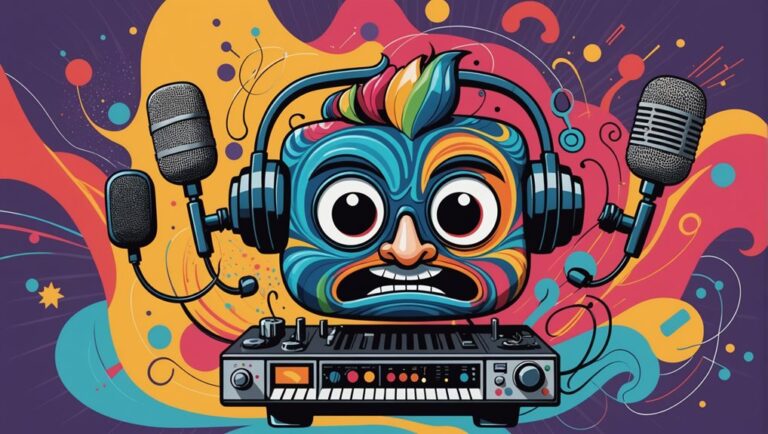Top 10 Animation Film Industry Revenue Projections
You're likely wondering what's driving the animation film industry's remarkable growth. The answer lies in the top 10 revenue projections, which forecast a staggering $10 billion cumulative revenue by 2025. Powerhouses like Disney, Pixar, Illumination Entertainment, and DreamWorks Animation are leading the charge, but they're not the only ones contributing to this unprecedented surge. As you explore the industry's landscape, you'll discover other key players and emerging studios that are shaking things up. The question is, which ones will solidify their positions and which new contenders will rise to the top?
Key Takeaways
- Disney's market dominance and Pixar's consistent billion-dollar blockbusters contribute significantly to the animation film industry's revenue projections.
- Illumination Entertainment's creative vision and attention to detail drive box office successes, further boosting industry revenue.
- DreamWorks Animation's revival through innovative storytelling and rebooted franchises also adds to the industry's revenue growth.
- The industry's revenue projections are also fueled by the nostalgia factor, with beloved characters and stories continuing to draw in audiences.
- The animation film industry's revenue is expected to continue growing, with projected annual increases driven by the success of these major studios.
Disney's Dominance Continues
As the animation film industry's revenue continues to soar, Disney's market share remains unchallenged, with its animated films consistently dominating the box office charts.
You might wonder what drives this success. One key factor is Disney nostalgia, which has been carefully cultivated over the years.
The company has successfully leveraged its rich history, creating a sense of familiarity and comfort for audiences of all ages. The Mickey Mouse legacy, in particular, continues to inspire new generations of fans.
With a vast library of beloved characters and stories, Disney has a treasure trove of intellectual property to draw from. This allows the company to produce films that are both nostalgic and fresh, appealing to both old and new fans alike.
As a result, Disney's animated films continue to break box office records, with recent hits like Frozen and The Lion King raking in billions of dollars worldwide.
With its market share remaining strong, it's clear that Disney's dominance in the animation film industry is here to stay.
Pixar's Billion-Dollar Blockbusters
While Disney's dominance in the animation film industry is undeniable, Pixar's consistent ability to churn out billion-dollar blockbusters has been a significant contributor to the studio's success.
You can't deny the impact Pixar has had on the industry, with a staggering 14 out of 15 films grossing over $500 million worldwide.
In fact, Pixar's evolution from a small studio to a global powerhouse has been nothing short of remarkable.
With films like Toy Story, Finding Nemo, and The Incredibles, Pixar has managed to create a loyal fan base that spans generations.
Pixar's impact on the industry extends beyond just box office numbers.
The studio's commitment to storytelling and innovation has raised the bar for animation studios worldwide.
You've likely noticed that many studios now aim to emulate Pixar's winning formula, combining stunning visuals with engaging narratives and lovable characters.
As a result, the animation film industry as a whole has benefited from Pixar's influence, with many studios producing high-quality films that resonate with audiences worldwide.
Illumination Entertainment's Rise
As you examine the animation film industry's revenue, you'll notice Illumination Entertainment's remarkable ascent.
The studio's creative vision has led to a string of box office successes, raking in billions of dollars worldwide.
Studio's Creative Vision
As you explore into the success of Illumination Entertainment, you'll notice that their creative vision has been instrumental in propelling the studio to the forefront of the animation film industry, with its unique blend of humor, style, and storytelling resonating with audiences worldwide.
Illumination's commitment to Visionary Storytelling and Artistic Freedom has allowed them to push the boundaries of animation, resulting in films that are both critically acclaimed and commercially successful.
| Aspect | Impact |
|---|---|
| Unique Blend of Humor | Broad appeal to diverse audiences |
| Innovative Storytelling | Increased engagement and emotional connection |
| Artistic Freedom | Unconventional ideas and fresh perspectives |
| Attention to Detail | Richly textured and immersive worlds |
| Emphasis on Character Development | Relatable and memorable characters |
Box Office Success
Illumination Entertainment's box office success has been nothing short of phenomenal, with its films consistently ranking among the highest-grossing animated movies of all time. You can't deny the studio's ability to craft movies that resonate with audiences worldwide.
Take Despicable Me, for instance, which has grossed over $3.7 billion globally. The Minions franchise has also raked in a whopping $3.7 billion, solidifying the studio's position as a major player in the animation industry.
What's behind Illumination's success? For one, the studio has mastered the art of merchandising opportunities. From toys to clothing, Illumination's characters have become household names, generating billions of dollars in revenue.
Additionally, the studio's films have had a significant cultural impact, with characters like Gru and the Minions becoming cultural icons. By tapping into popular culture, Illumination has created a loyal fan base that enthusiastically anticipates each new release.
As you analyze the studio's success, it's clear that their winning formula is a combination of clever storytelling, lovable characters, and strategic merchandising opportunities.
DreamWorks Animation's Revival
As you examine DreamWorks Animation's resurgence, you'll notice a trifecta of strategic moves that have contributed to its success.
You'll see that the studio's new creative direction has paved the way for refreshed storytelling approaches.
New Creative Direction
DreamWorks Animation's revival was sparked by a deliberate shift towards a new creative direction, characterized by a renewed focus on storytelling and innovative animation techniques.
You'll notice that their recent films have taken a bold step away from tired formulas and towards fresh narratives that captivate audiences of all ages. This strategic move has paid off, with films like 'Abominable' and 'The Croods: A New Age' receiving critical acclaim and raking in millions at the box office.
As you plunge deeper, you'll see that DreamWorks' innovative storytelling is key to their success.
By pushing the boundaries of animation and exploring new genres, they're able to create unique and engaging storylines that set them apart from the competition.
For instance, 'Spirit Untamed' blended traditional animation with cutting-edge technology to create a visually stunning film that wowed audiences worldwide.
Rebooting Classic Franchises
Rebooting beloved franchises has proven to be a lucrative strategy for DreamWorks Animation, with revamped classics like 'Shrek' and 'Kung Fu Panda' generating massive revenue and reinvigorating interest in the studios' iconic characters. By leveraging nostalgia marketing, the studio has successfully tapped into the sentimental value of these classic franchises, appealing to both old and new audiences. This approach has not only revitalized interest in the original films but also paved the way for new merchandise, spin-offs, and sequels.
| Franchise | Revenue (Billions) |
|---|---|
| Shrek | 1.4 |
| Kung Fu Panda | 1.8 |
| Madagascar | 1.9 |
| How to Train Your Dragon | 1.5 |
| Puss in Boots | 1.2 |
You can see from the table above that these reboots have generated significant revenue for the studio. The success of these classic revivals is a badge of honor to the power of nostalgia marketing, which has become a key strategy for DreamWorks Animation's revival. By rebooting these beloved franchises, the studio has positioned itself for continued success and growth in the animation film industry.
Diversifying Storytelling Genres
By venturing into diverse storytelling genres, you're witnessing DreamWorks Animation's deliberate shift towards appealing to a broader audience and staying relevant in an increasingly competitive market.
This strategic move is driven by the need to cater to evolving viewer preferences and tap into new revenue streams. Particularly, the studio has been focusing on cultural representation, ensuring that its films better reflect the diversity of its global audience.
For instance, the success of 'Abominable' (2019) demonstrates the potential of culturally sensitive storytelling, with the film's Chinese-inspired narrative resonating with viewers worldwide.
Furthermore, DreamWorks Animation has been actively promoting female protagonists, recognizing the untapped potential of this demographic.
Films like 'The Croods' (2013) and 'Spirit: Stallion of the Cimarron' (2002) feature strong, independent female characters, appealing to a previously underserved audience segment.
By diversifying its storytelling genres, the studio isn't only enriching its narrative palette but also expanding its commercial appeal.
As the animation film industry continues to evolve, DreamWorks Animation's proactive approach to diversification is likely to yield significant revenue growth and cement its position as a market leader.
Sony Pictures Animation's Surge
Sony Pictures Animation's box office performance has seen a significant upswing in recent years, with its 2017 film 'Spider-Man: Into the Spider-Verse' grossing over $375 million worldwide and earning widespread critical acclaim.
You can attribute this success to Sony's commitment to building on its legacy, while also driving animated innovations.
By leveraging its rich intellectual property, such as Spider-Man, Sony has been able to tap into existing fan bases, ensuring a built-in audience for its films.
Furthermore, the studio's willingness to experiment with new styles and techniques has helped it stay ahead of the curve.
For instance, 'Spider-Man: Into the Spider-Verse' featured a groundbreaking visual style that blended traditional animation with computer-generated imagery.
This innovative approach not only resonated with audiences but also earned the film an Academy Award for Best Animated Feature.
As you consider the current state of the animation film industry, it's clear that Sony Pictures Animation is well-positioned to continue its surge in the coming years.
Netflix's Animated Ambitions
You're witnessing a seismic shift in the animation landscape, driven largely by Netflix's ambitious plans.
With an estimated $15 billion allocated to original content in 2020, Netflix is aggressively expanding its animation slate, signaling a significant shift in its content strategy and posing a substantial challenge to traditional studios.
This investment is expected to yield a diverse range of original IPs, catering to diverse audiences and demographics. Netflix's content strategy is centered around creating immersive, engaging stories that resonate with viewers worldwide.
By doing so, the streaming giant aims to capture a larger share of the animation market, currently dominated by traditional studios.
You can expect Netflix to focus on developing unique, high-quality content that sets it apart from competitors.
The platform's data-driven approach allows it to identify emerging trends and audience preferences, informing its content development decisions.
As Netflix continues to push the boundaries of animation, you can anticipate a surge in innovative storytelling, unique visual styles, and engaging characters.
The implications are clear: Netflix's animated ambitions have the potential to disrupt the traditional animation industry, forcing established players to re-evaluate their content strategies and adapt to the changing landscape.
Warner Bros. Animation's Resurgence
As Netflix's animation ambitions continue to shake up the industry, Warner Bros. Animation is quietly staging a resurgence, bolstered by its rich legacy of beloved characters and a renewed focus on innovative storytelling.
You're witnessing a Warner Bros. Renaissance, with the studio's Animation Revival strategy yielding impressive results. The numbers don't lie: Warner Bros. Animation's revenue has seen a significant uptick in recent years, driven by the success of films like 'Space Jam: A New Legacy' and 'Tom & Jerry.'
The studio's commitment to revitalizing classic IPs has paid off, with a slew of upcoming projects in development.
Warner Bros. Animation's resurgence is also fueled by its expansion into new areas, such as anime and adult animation.
The studio's partnership with Crunchyroll has opened up new opportunities for co-productions and acquisitions, further diversifying its portfolio.
With a robust slate of films and TV shows in the pipeline, you can expect Warner Bros. Animation to continue its upward trajectory.
As the animation landscape continues to evolve, Warner Bros. is well-positioned to capitalize on emerging trends and technologies, solidifying its status as a major player in the industry.
Universal Pictures' Animated Ventures
Universal Pictures is strategically expanding its animated offerings, leveraging its rich history of family-friendly entertainment to tap into a burgeoning market driven by growing demand for high-quality, visually stunning content. You'll notice that the studio is reviving classic characters to appeal to both old and new audiences. For instance, Felix the Cat, a beloved Universal Classics character, is getting a reboot. This move is expected to drive revenue growth and increase brand recognition.
Here's a snapshot of Universal Pictures' animated ventures:
| Title | Release Date |
|---|---|
| Felix the Cat: The Movie | 2024 |
| The Addams Family 2 | 2023 |
| Sing 2 | 2022 |
| Minions: The Rise of Gru | 2022 |
| The Secret Life of Pets 3 | 2023 |
As you can see, Universal Pictures has a robust pipeline of animated films scheduled for release in the coming years. With a focus on quality storytelling and stunning visuals, the studio is poised to capitalize on the growing demand for animated content. By leveraging its rich history and iconic characters, Universal Pictures is well-positioned to increase its market share in the animation film industry.
Laika's Stop-Motion Success
While major studios like Universal Pictures are betting big on computer-generated imagery (CGI), Laika, a Portland-based animation studio, has carved out a niche for itself with its unique stop-motion technique, yielding impressive box office returns and critical acclaim.
You might be wondering what sets Laika apart from its CGI counterparts. The answer lies in its meticulous attention to detail and dedication to crafting characters that resonate with audiences.
Laika's stop-motion evolution has allowed it to push the boundaries of storytelling, creating immersive worlds and characters that feel tangible and relatable.
Take, for instance, the studio's 2016 release, Kubo and the Two Strings, which grossed over $76 million worldwide.
The film's success can be attributed to Laika's innovative use of stop-motion, which enabled the creation of intricate sets and characters that seemed to leap off the screen.
By combining traditional techniques with modern technology, Laika has managed to stay ahead of the curve, producing films that are both visually stunning and emotionally resonant.
As the animation industry continues to evolve, Laika's commitment to stop-motion is a badge of honor to the power of innovative storytelling and attention to detail.
International Studios on the Rise
What's driving the surge in international studios' market share, and how are they challenging the dominance of traditional powerhouses in the animation film industry?
You're likely to find the answer in the growing cultural influences and global partnerships that are reshaping the animation landscape. International studios are leveraging their unique cultural perspectives to create content that resonates with diverse audiences worldwide.
For instance, Japan's Studio Ghibli has been a trailblazer in this regard, producing films that blend traditional Japanese culture with modern storytelling. Similarly, studios in Europe, Latin America, and Asia are capitalizing on their regional strengths to produce content that appeals to local tastes.
As a result, international studios are forging global partnerships to expand their reach and capabilities. Collaborations between studios, distributors, and streaming platforms are enabling the production of high-quality content that can compete with traditional industry leaders.
According to recent data, international studios now account for over 30% of the global animation market share, up from 20% just five years ago.
As the industry continues to evolve, you can expect international studios to play an increasingly important role in shaping the future of animation.
Frequently Asked Questions
What Percentage of Animation Revenue Comes From Merchandise Sales?
You'll find that around 20-30% of animation revenue comes from merchandise sales, largely driven by licensing agreements that capitalize on franchise longevity, ensuring a steady stream of revenue beyond box office numbers.
How Do Animation Studios Handle Intellectual Property Rights?
You'll find that animation studios carefully manage IP rights through robust protection strategies, vigorously pursuing copyright infringement lawsuits to safeguard their creative assets, ensuring maximum revenue generation from their intellectual properties.
Are Animation Film Budgets Increasing or Decreasing?
You'll find that animation film budgets are increasing, driven by rising production costs and demands for high-quality visuals. However, budget constraints often compromise creative liberties, forcing studios to balance artistic vision with financial realities.
What Is the Average Production Time for an Animated Film?
You'll find that the average production time for an animated film typically spans 3-5 years, with 1-2 years devoted to script development and pre-production planning, and the remaining time allocated to actual production and post-production tasks.
Do Animation Studios Prioritize 2D or 3D Animation Techniques?
You'll find that animation studios weigh artistic preference against technical limitations when deciding between 2D and 3D techniques, as each approach offers unique storytelling benefits and production challenges that impact the final product's quality and feasibility.
Conclusion
As you examine the top 10 animation film industry revenue projections, it's clear that the future is bright.
With Disney's continued dominance, Pixar's blockbuster franchises, Illumination's creative vision, and DreamWorks' revival, the industry is poised for unprecedented growth.
Add to that Sony Pictures Animation's surge, Warner Bros. Animation's resurgence, and Universal Pictures' animated ventures, and you've got a recipe for success.
Laika's stop-motion success and international studios on the rise only sweeten the deal, making the $10 billion revenue projection by 2025 a conservative estimate.







